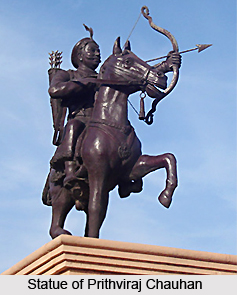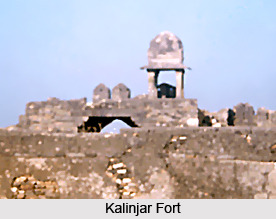H istory of Mahoba District suggests that the name Mahoba is derived from `Mahotsav Nagar`, the city of great festivals, which were celebrated here by Chandra Verman, founder of the Chandella Dynasty. Another tradition preserves three other names of the city - Kekaipur, Patanpur and Ratanpur. Before the rise of Chandellas, Mahoba was held by the Gaharwar and Pratihar clans of Rajputs. The Chandela ruler Chandra Verman, who hailed from Maniagarh, took it over from Pratihar rulers and adopted it as his capital. Later, Vakpati, Jejja, Vijai Shakti and Rahila Deva succeeded him.
istory of Mahoba District suggests that the name Mahoba is derived from `Mahotsav Nagar`, the city of great festivals, which were celebrated here by Chandra Verman, founder of the Chandella Dynasty. Another tradition preserves three other names of the city - Kekaipur, Patanpur and Ratanpur. Before the rise of Chandellas, Mahoba was held by the Gaharwar and Pratihar clans of Rajputs. The Chandela ruler Chandra Verman, who hailed from Maniagarh, took it over from Pratihar rulers and adopted it as his capital. Later, Vakpati, Jejja, Vijai Shakti and Rahila Deva succeeded him.
Among the later Chandela rulers whose names are particularly associated with some of the local monuments are Vijai-pal (1035-1045 AD) who built the Vijai Sagar Lake, Keerti Verman (1060-1100 AD) built Keerat Sagar Tank and Madan Verman (1128-1164 AD) who built Madan Sagar. The last prominent Chandella ruler was Parmardi Deva or Parmal whose name is still popular due to the heroic deeds of his two Generals `Alha` and `Udala` who own many battles. Further, according to the history of Mahoba District, the reign of Parmardi Deva or Parmala, the 15th ruler of the dynasty witnessed the fall of Mahoba. In 1182 AD, differences arose between Parmala and Delhi king Prithviraj Chauhan who gave an ultimatum stating certain conditions to be fulfilled by Parmala or to surrender. Eventually, Mahoba was seized. And his General Chamund Rai even made a surprise attack on the region.
 Later, Prithviraj Chauhan captured Mahoba despite the brave fight put-up by the Banafer brothers: Alha and Udal. Parmala had to retreat to Kalinjar leaving Mahoba in the hands of the conqueror. This event is considered as the beginning of the end of Chandella rule over the region. Two decades later, Qutub-Ud-Din Aibak vanquished Mahoba and Kalinjar in 1203 AD. Later, Trailokya Verman, another son of Parmala, recovered Mahoba and Kalinjar but the Chandellas lost their eminence in the region. Mahoba had to lose its independence and it became a part of the Delhi Sultanate. After about two centuries of obscurity, Chandela ruler Keerat Pal Singh rose to power and re-established his domain over Kalinjar and Mahoba. Keerat Pal Singh battled bravely with Sher Shah Suri, while defending Kalinjar Fort in 1545 AD. Sher Shah, however, captured the fort.
Later, Prithviraj Chauhan captured Mahoba despite the brave fight put-up by the Banafer brothers: Alha and Udal. Parmala had to retreat to Kalinjar leaving Mahoba in the hands of the conqueror. This event is considered as the beginning of the end of Chandella rule over the region. Two decades later, Qutub-Ud-Din Aibak vanquished Mahoba and Kalinjar in 1203 AD. Later, Trailokya Verman, another son of Parmala, recovered Mahoba and Kalinjar but the Chandellas lost their eminence in the region. Mahoba had to lose its independence and it became a part of the Delhi Sultanate. After about two centuries of obscurity, Chandela ruler Keerat Pal Singh rose to power and re-established his domain over Kalinjar and Mahoba. Keerat Pal Singh battled bravely with Sher Shah Suri, while defending Kalinjar Fort in 1545 AD. Sher Shah, however, captured the fort.
History of Mahoba District also talks about the account of Rani Durgavati`s deeds. She administrated her territory admirably well after the death of Raja Dalpat Shah and in 1564 AD gallantly resisted the unprovoked aggression of Akbar, Mughal Emperor. However, in the post Chandela period the history of Mahoba District gets obscure. It was under the reign of Delhi Sultans. Local traditions ascribe and associate Bhar and Gond Tribe who held their administrations in the region from time to time. Later, with the rise of Chhatrasal Bundela, Mahoba passed under his sway but failed to acquire and kind of pre-eminence. In 17th century AD Chhatrasal declared independence and put a stiff resistance against Aurangzeb.
Later, under the treaty of Bassein in 1803 AD the Marathas ceded Bundelkhand area to British rulers. Its administration was, however, carried over by the subedar of Jalaun until 1858 AD when it was finally annexed by the East India Company. Mahoba was made the headquarters of a sub-division in the district of Hamirpur. Its later history is un-eventful except for the local revolt in the first freedom struggle of 1857 AD. Mahoba District also contributed in the freedom struggle of the country. Mahoba District came into existence on 11th of February, 1995.



















